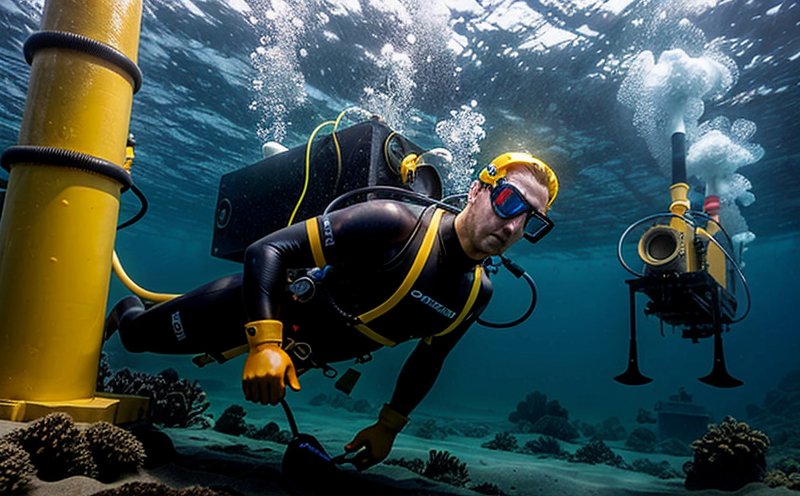ASTM F3365 Pressure Testing of Subsea Connectors
The ASTM F3365 standard is a critical benchmark in the marine and ship equipment testing sector, especially for subsea connectors. This test ensures that these connectors can withstand the harsh pressure conditions found at depths below 100 meters, where traditional surface testing methods are inadequate.
Subsea connectors play an essential role in the integrity of deep-sea operations by connecting pipelines, umbilicals, and other equipment. Their reliability is paramount to prevent costly failures that could lead to environmental damage or operational downtime. ASTM F3365 provides a standardized approach for manufacturers and end-users to validate connector performance under simulated subsea conditions.
The pressure testing process involves subjecting the connector to hydrostatic pressure in a controlled environment mimicking its intended operating depth. This ensures that the connector remains intact, free from leaks or damage, even when subjected to extreme pressures. The test is conducted using specialized equipment capable of simulating deep-sea conditions, including temperature and salinity levels.
The specimen preparation for ASTM F3365 involves selecting connectors representative of those used in real-world applications. This includes ensuring the connector meets all dimensional and material requirements specified by the manufacturer and relevant standards. Once prepared, these specimens undergo rigorous testing to verify their integrity under pressure.
Instrumentation plays a crucial role in ASTM F3365 testing. High-pressure pumps capable of generating up to 10 MPa are used to apply hydrostatic pressure gradually, starting from atmospheric pressure and increasing until the connector fails or reaches its maximum rated pressure. Pressure gauges and sensors continuously monitor the applied pressure and the integrity of the specimen during the test.
Once the testing is complete, detailed reports are generated summarizing the results. These reports include data on the pressure applied, the duration of exposure to that pressure, any observed deformation or leakage, and a conclusion regarding the connector's compliance with ASTM F3365 standards. This information is invaluable for quality assurance teams in ensuring product reliability.
The ASTM F3365 test is not only critical for new product development but also essential for quality control during production processes. By adhering to this standard, manufacturers can demonstrate their commitment to delivering products that meet the highest industry standards and are fit for use in challenging subsea environments.
Applied Standards
The ASTM F3365 pressure testing of subsea connectors is a key component of ensuring marine equipment reliability. This test aligns with broader international standards such as ISO 10749, which provides guidelines for the design and fabrication of subsea pipelines, and EN 10286-1, which covers the quality assurance requirements for pressure equipment.
The ASTM F3365 standard specifically addresses the testing methods used to evaluate the mechanical properties of subsea connectors under simulated deep-sea conditions. It specifies the test setup, including the type of hydraulic fluid and the rate at which pressure is applied during the test. The standard also outlines acceptance criteria that must be met for a connector to pass the test.
For example, a connector passes ASTM F3365 if it remains intact without any signs of leakage or deformation after reaching its maximum rated pressure. This ensures that connectors are not only capable of withstanding high pressures but can also perform reliably in real-world subsea environments.
Quality and Reliability Assurance
Consistent adherence to ASTM F3365 standards enhances quality assurance by ensuring that all connectors meet the required mechanical properties. This includes checking for material consistency, dimensional accuracy, and surface finish during manufacturing.
Regular calibration of testing equipment ensures accurate pressure readings throughout the test process. Proper calibration is crucial for maintaining the integrity of the test results and ensuring compliance with ASTM F3365 standards.
Data logging systems are used to record all relevant parameters during the testing process, including temperature, salinity, and pressure levels. These records provide valuable insights into connector performance under simulated subsea conditions.
Independent third-party inspections can verify that manufacturers comply with ASTM F3365 standards. This provides additional assurance for end-users that the connectors they purchase meet the highest quality and reliability benchmarks.
By implementing these measures, laboratories can provide clients with comprehensive testing services that ensure the reliability of subsea connectors used in critical marine operations.
International Acceptance and Recognition
The ASTM F3365 pressure test for subsea connectors is widely recognized across the global maritime industry. It is accepted by major oil and gas companies, shipbuilders, and other organizations involved in deep-sea operations. The standard is part of the broader suite of standards that govern the design, fabrication, and quality assurance of marine equipment.
Many international regulations and certifications require compliance with ASTM F3365 as a condition for approving subsea connectors for use in specific projects or regions. For instance, the International Maritime Organization (IMO) and various national regulatory bodies incorporate these standards into their guidelines to ensure safety and reliability in deep-sea operations.
End-users of subsea equipment often specify ASTM F3365 as a requirement when placing orders with manufacturers. This ensures that they receive products that have been rigorously tested and proven capable of performing reliably under the conditions where they will be used. Compliance with this standard is thus not only a technical necessity but also a commercial imperative.





